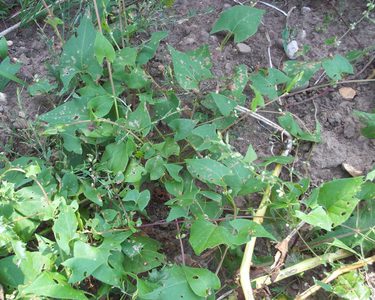Black bindweed

Other names
bedwine, bunwede, climbing buckwheat, devil.
Latin names
Fallopia convolvulus (L.)
Weed Type
Annual Broad-leaved Weeds
Where would I find black bindweed?
Black bindweed is native in waste places, gardens, and on arable land. It is a troublesome annual weed that twines around and drags down both cereal and root crops. It is common on light sandy soils, loams, and clay but rare on chalk. It is recorded up to 1,500 ft in Britain.
There is some variation in morphology according to habitat. Before the flowers develop it is often mistaken for field bindweed, Convolvulus arvensis.
In Britain, black bindweed seeds are a common food in the diet of the grey partridge. The seeds are also considered valuable stock feed and some farmers collect up the screenings and feed them to livestock. This is risky if the seeds are not ground or scalded as viable seeds could be returned to the field in manure.
Biology
Black bindweed flowers from July to August, sometimes into October. All stages of flowering can be found on mature plants from new buds to ripe seeds. Each flower produces a single seed. Seed numbers per plant are given as 140 to 200 but a large plant can produce 11,900 seeds. Seed is shed from August onwards.
Seed is normally dormant when mature, in part because of the impermeable seedcoat. Scarification promotes germination but light has no apparent effect. Stratification for several weeks at low temperature over the winter encourages subsequent germination in spring. Most seedlings emerge from March to May. Seed dormancy is re-imposed in response to rising temperatures in early summer.
In the field, black bindweed seedlings emerge from the top 95 mm of clay and sandy loam soils. The majority come from the surface 60 mm with just the odd seedling from further down the soil profile. Seeds can emerge from as deep as 190 mm in soil.
Does black bindweed spread easily?
Seed longevity in soil is given as 4 to 5 years but seeds recovered from excavations and dated in excess of 30 years are reported to have germinated. It does not appear to persist in cultivated soil for as long as the seed of many other weeds. In some field studies, the seedbank was exhausted after just 3-4 years. Black bindweed seeds sown in the field and followed over a 5-year period in winter wheat or spring barley showed an annual decline of 40%. Emerged seedlings represented 8% of the seedbank.
In cattle, rumen digestion causes a gradual decline in seed viability but viable seeds may be found in manure. Seed did not germinate after an 8-week period of ensilage and rumen digestion. Seeds were no longer viable after 2 weeks windrow composting at 50-65°C. The seeds survive ingestion by birds.
Black bindweed seed has been a major contaminant of cereal grain. Many seeds are shed in the field at and after cereal harvest. Grain transport is thought to be a major factor in the spread of this weed around the world. Black bindweed seed was one of the most frequent seed contaminants in samples of cereal seed taken for official testing. Seed has also been recovered from irrigation water.
How to manage black bindweed organically
Seedlings emerge early in the year and are controlled by surface cultivation in spring. If crop drilling is delayed, more of the early flush of black bindweed seedlings can be killed by cultivation. In spring wheat, increasing the sowing density reduced black bindweed biomass and seed production. The collection and destruction of seed caught in the combine at harvest reduces seed return to the soil. Harrowing the stubble immediately after harvest may encourage some seeds to germinate so that the seedlings can be destroyed at ploughing but most seed will remain dormant until early the following year. Short rotations and the hoeing of root crops will help to keep the weed under control.
Fallowing for a year has reduced seed numbers in soil by 70% but a similar reduction is achieved by cropping with winter wheat and carrying out normal weed control measures to minimise seed return.
A number of insects and fungi infest black bindweed and it is also a host of some economically important viruses.